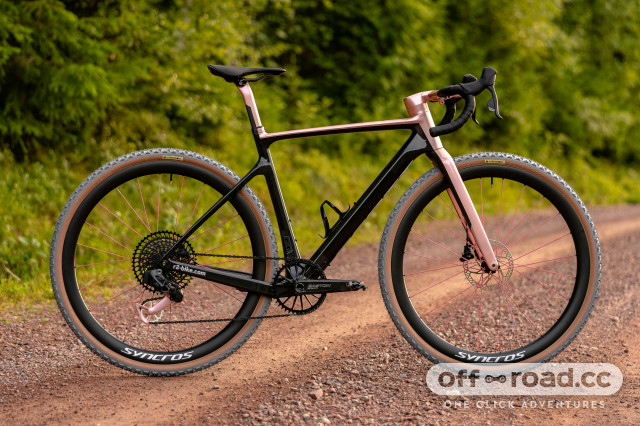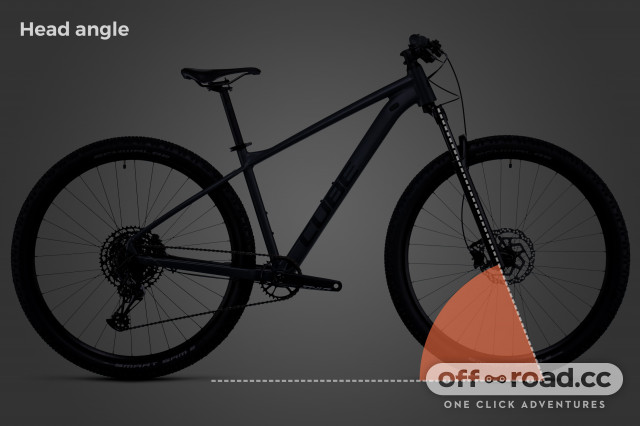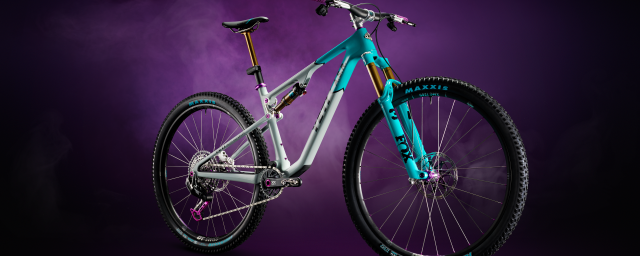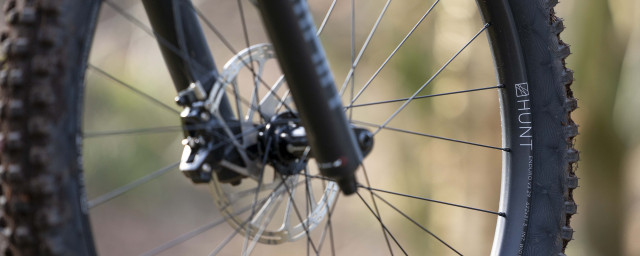Women's bike vs unisex bike - understanding the differences

Women-specific bikes are becoming a rather rare sight on the bike market. Similar to what we’ve already seen with cycling shoes and saddles, some of the largest bike manufacturers, such as Trek, Canyon and Specialized, have dropped their women-specific bike names and integrated them all into unisex ranges. That doesn't mean that there aren't still women-specific bikes out there - and that you shouldn't consider one.
- Women’s bicycle saddle guide - how to choose the best saddle
- Gravel cycling: experiencing a women's bikepacking event
- Mountain bike fitness - how to improve your MTB performance
While some brands have dropped the gendered bike labelling, others - for example, Liv, Scott and Juliana - still believe there is a need for women-specific bikes. Not all women need a women-specific bike, nor do the gender-specific bikes only fit one gender - but there are quite a lot of differences between the unisex and women's bike ranges, all made to help you to achieve a better bike fit.
So what really makes a unisex and women’s bike different? Let’s have a look at some of the most prominent differences - and how those might or might not suit your needs as a female cyclist.
The touchpoints
The most apparent aspect of women-specific bikes is the touchpoints. These include the cockpit (handlebars and stem), the pedals (or more widely, the cranks) and the saddle. All of these are relatively easy to swap, but getting a bike that is already fine-tuned for your needs, straight out of the box, is even better.
Women-specific bikes often feature saddles that have been proven to work with female anatomy - and we have looked at this more in-depth in the women's saddle guide. Many brands say all of their saddles fit any gender but some, such as Specialized Mimic saddles and Liv saddles, have taken this a step further and focused on the female anatomy in the seat design.
If you've bought a unisex bike that doesn't have a saddle you feel comfortable on, swapping it out is not necessarily the biggest investment (although the best mountain bike saddles easily set you back £200). Yet is simply convenient to have a fully built bike that suits you straight out of the box - and a women-specific saddle is more likely to do that.
Moving on to the front of the bike: the handlebars. On women’s bikes, the handlebars are usually narrower than the unisex ones. For example, Juliana Furtado, the brand's 130mm trail bike, comes with 760mm Burgtec RideWide Alloy Bars. The Santa Cruz 5010, the unisex equivalent of this bike, comes with the same bars but in 800mm width.
Similarly, with gravel bikes, the size small Liv Devote Pro comes with 400mm bars, whereas the Giant Revolt Advanced Pro has 420mm bars. And the list of examples could go on and on. Generally, women have narrower shoulders than men and hence benefit from a narrower handlebar design.
And finally, the third touchpoint: pedals. Pedals themselves don’t usually really need to be personalised based on the rider's physiology, but crank length is a different matter. Crank length is a very important aspect of ride comfort and efficiency, and as a general rule, women’s bikes come with shorter cranks.
Sometimes this is not possible because of the groupset the bike comes with - the shortest crank length in the range might be 170mm - but you can find that the women-specific bike has 165mm cranks, whereas the unisex bike only comes with 170-, 172.5- or 175mm options.
Why do manufacturers make these seemingly small changes to the bikes, then? Generally, women and men have different physiology and women tend to have narrower shoulders, longer torsos and shorter legs - and the subtle changes to the bike finishing kit can accommodate these features. That said, the touchpoints on any bike are easily changed - and you might want to change them to suit your specific riding needs and style even if your bike already came with the ideal saddle and handlebar width.
Again, there are huge variations in the physique and preferences of riders, so it's not a given that a women-specific bike with a women-specific finishing kit fits all women perfectly. However, having a women-specific bike might fit you a lot better than a unisex one - and save you from upgrading the touchpoints immediately. Having a comfortable and well-fitting saddle, handlebars and cranks are essential for any cyclist to enjoy their ride.
Geometry
Then we have the actual frame geometry of the bike. There are some differences in the angles and measurements between unisex and women’s bikes. Understanding bike geometry can be tricky - it's a lot of angles and measurements - so we have put together a bike geometry guide that can help you get started when you compare two bikes.
The easiest way to showcase the geometry differences between women's and unisex is to look at two different bike models - one being a women-specific bike and the other a unisex model. If you look at Liv Embolden 1 and Giant Stance 1, you can see the geometry charts for each bike are vastly different - although the bike is the exact same, with the same components and intended use. But throughout the size range, the Embolden has steeper seat and head tube angles than the Stance, the chainstay is shorter and the wheelbase is longer. A similar trend is true if you compare Liv and Giant gravel bikes - the Liv is more likely to have a steeper seat tube angle and slacker head angle.
For some bikes that have different touch points, the geometry does not differ at all. This is true for Juliana Furtado and Santa Cruz 5010, as these two trail bikes have identical measurements in similar-sized frames, despite the difference in touch points.
You might think a degree here and there isn't much but, actually, all of these measurements make a big difference in how the bike rides. Slacker angles generally mean a less reactive, but more stable bike, whereas steeper angles and shorter wheelbase give you the opposite and are preferable especially if you want a punchy race bike.
For you to know what kind of bike fits you best, it’s a good idea to get a bike fit that defines the best bike geometry specifically for you. What kind of bike fits you best depends on a range of things: your physiology; your height, the length of your arms, and the width of your shoulders but also on aspects such as the style of riding and personal preferences - or injuries. Even if you are the exact same height as someone else, a different size bike can fit each of you the best.
Size range
Sometimes, as a woman (or in general, as a smaller, more petite rider), it feels impossible to find a bike that is small enough. This is where women-specific bike range offerings often beat the unisex ranges.
Many non-gendered bike models are available in sizes catering for riders taller than 5'4" - even though the average UK woman is 5'3" tall. This means that many women are overlooked by bike manufacturers and have to compromise when purchasing a bike. While you can make a slightly too large bike fit you by changing the stem, handlebars and or stack height, all of this can compromise the handling.
Fitting a very short stem on a too large-a-frame will affect the handling, making the bike twitchy and unbalanced, and having barely any of your seatpost visible can affect your comfort as the post has not as much chance to flex on bumps. Although there seldom is the need for it, it is easier to make a bike that is too small to fit you than shrink a bike that is too large.
Canyon, Specialized and Liv are great examples of bike brands offering small frames for shorter riders - the smallest Specialized bikes are suited for riders from 4'11" in height, whereas Liv's smallest gravel bikes are suited for riders taller than 5'0".
Here it is also worth noting that the way bike brands define bike sizes vary massively. Some go for small, medium, and large, whereas some list numbers such as 44, 49, 54 and so on. While these are good to get an idea of the range, you should not ever assume that two bikes with the same size label are actually in any way the same across brands and ranges. It is more useful to compare two bikes for example by their effective top tube length,
Generally, the women-specific bike ranges often extend more into the smaller sizes - for example, Liv Devote comes in from XS to L, whereas Giant Revolt is offered in S to XL sides. The top tube length of the Small Revolt (550mm) is the same as that of the Large Devote, suggesting that most of the women-specific bikes are considerably smaller than the unisex ones in this gravel range. If you are unsure of what size bike you should look for in the first place, our mountain bike size guide is good for understanding what the geometry measurements mean so you can find the best-fitting bike for you.
Suspension tuning
Women-specific mountain bikes come with different shock tunes to reflect the different requirements women riders might have. Liv told us it custom-tunes the shocks for each Liv full suspension platform - to the needs of women riders.
"When we approach the development of our full-suspension mountain bikes, we are looking to dial in the shock’s shim stacks, volume spacers, and air pressures that suit the product for the intended ride experience and rider. Weight is a factor when tuning and we consider the target weight range we are looking to support across all frame sizes and platforms."
"Ludi, Liv's off-road and gravel category manager, leads this process with our suspension partners and is personally involved in many rounds of testing for each bike platform before signing off on the final tunes. This year she also had Liv Racing Team Manager Elizabeth (Liz) Walker involved in the annual tuning camp. In years past, we’ve also included our professional athletes when schedules allowed. Why do we do this? Because we can and it matters to us that women inform products designed for women," Jen Audia Liv's Global Marketing Specialist, explains.
So if you are debating between a unisex and a women's mountain bike, this might be a crucial difference for you - although you can always fine-tune our suspension further at home.
Smaller wheels
When you have a small frame, you also might want smaller wheels. Of course, sometimes even the smallest of mountain bikes will have 29-inch wheels - so this is also dependent on your riding style and preference.
In general, smaller frames create a geometry that subjects the rider to a lot of toe overlap (where your toes hit the front tyre when you turn the handlebars) and steep angles that might make the bike feel unstable. The gyroscopic forces from bigger wheels fitted to a smaller frame can also have a significant impact on the bike's performance and the rider's confidence. To accommodate this, brands such as Canyon have developed specific small bike geometries.
This means that in some ranges, the smallest frame sizes only take a smaller diameter 650b wheel, rather than the standard 700c size. Although the difference between the two wheel sizes is not huge it is enough to change the way the bike rides dramatically - and you are rewarded with much less toe overlap.
So again, make sure you do your homework on geometry: pay attention to the head and seat tube angles and the wheelbase and check if the bike can take smaller 650b wheels. The steeper the angles, the speedier and more reactive the bike is, whereas slacker angles give you more stability - and smaller wheels allow more toe clearance.
Colourways and names
In some ways, the naming of women-specific bike models is the first, most obvious difference. Scott has added ‘Contessa’ to its women’s range whereas Liv and Juliana represent stand-alone brands of women-only bikes.
The naming of the specific models differs as well, so if you are comparing two models between the unisex ranges, it might take a while to find the equivalents. For example Scott Spark 920 is practically the same bike as Scott Contessa Spark 910. Some examples from Liv and Juliana have already been mentioned above: Juliana Furtado and Santa Cruz 5010 are much the same, as are Liv Devote and Giant Revolt.
"Shrink it and pink it" is an (often loaded) phrase you might hear in conversations about women's bikes - and this used to be well true in the past when women's and unisex bike ranges were quite starkly different in terms of colourways. Although colour has nothing to do with the performance of a bike, it's still good to enjoy looking at your bike.
Even today, different bike ranges feature different colourways - but not all women's bikes have pink or baby blue colourways. For example, the Scott Contessa Spark 920 is purple, and the equivalent Scott Spark 920 is grey. If colour is a decisive factor for you and there is a size in both ranges that fits you, then you have more options if you look over both ranges.
[Cover photo by Sarah Hewitt/S.Hewittphotography]

















1 comments
Given the current trend in unisex bikes for aggressive names and endless gray/black/charcoal colourways I'm sure I'm not the only bloke to have considered buying a Liv Avail rather than a Defy Advanced. Same applies to the Revolt. Given how tiny the model name logos are it's almost like Giant feel they need to apologize too.